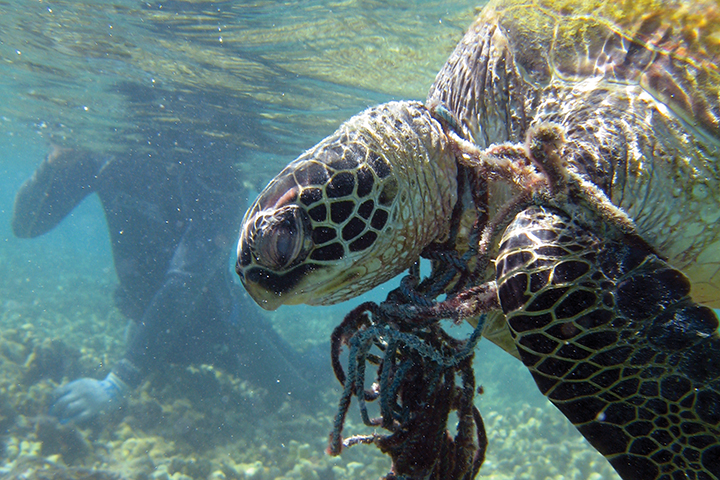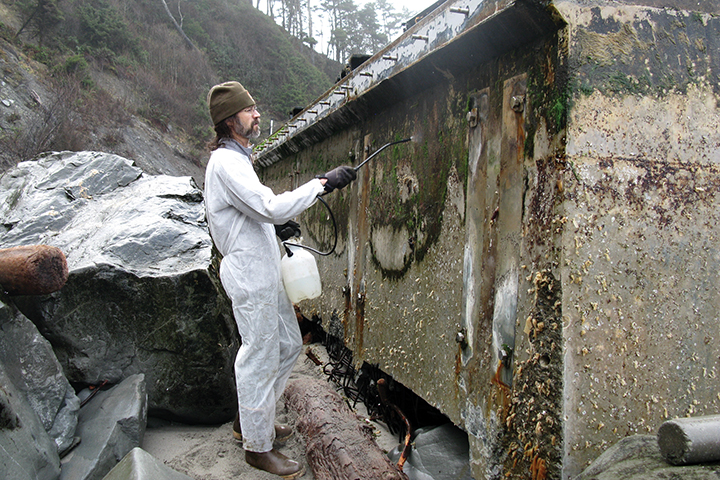NOAA Marine Debris Program Fiscal Year 2013 Accomplishments
The NOAA Marine Debris Program (MDP) of the Office of Response and Restoration leads national efforts to research, prevent, and reduce the impacts of marine debris. Its staff, positioned across the country, support marine debris projects in partnership with state and local agencies, tribes, nongovernmental organizations, academia, and industry. The program also spearheads national research efforts and works to change behavior in the public through education and outreach initiatives.

Nearly $2 Million for Community-Based Marine Debris Removal, Research, and Prevention
In September 2013, NOAA MDP provided a total of $1,916,512 in grants and cooperative agreements to 22 state, local, and non-profit organizations through three successful competitions. Working with NOAA's Restoration Center, NOAA MDP supports locally driven, community-based marine debris prevention and removal projects.
Eleven groups from across the country received funding to remove derelict fishing nets, litter, lumber, tires, and other harmful marine debris from shorelines and coastal waters. The Prevention, Education, and Outreach competition selected eight projects focusing on regional and national marine debris outreach and education efforts that encourage behavior change. Three research grants were selected, which focus on the potential chemical impacts of plastic marine debris on the environment.
New Legislation Expands Scope of NOAA Marine Debris Program
In December 2012, Congress passed legislation reauthorizing the NOAA Marine Debris Program. The amended Marine Debris Act largely preserved the program's mandates to research, prevent, reduce, and remove marine debris, but it added a new core function: addressing severe marine debris events. The bill recognizes both the need to deal with the unusual amounts and types of marine debris following events such as tsunamis or hurricanes, as well as NOAA’s critical role, placing the program at the forefront of coordination and scientific support for these events.
Addressing Japan Tsunami Marine Debris
The NOAA Marine Debris Program's (MDP) response to marine debris arriving on U.S. shores from the 2011 Japan earthquake and tsunami stretched into the 2013 fiscal year. As work continued in the states on regional response plans and cleanup, winter ushered in two major events that spurred activity for the program: a $5 million gift from Japan and a second Japanese dock landing on a U.S. coast.
Funding to States
In December 2012, the Government of Japan gifted $5 million to the United States, through NOAA MDP, to support debris cleanup and response activities. NOAA MDP distributed funds to states through formal agreements, providing an initial $250,000 each to Alaska, Washington, Oregon, California, and Hawaii.
Olympic Coast Dock Removal
The significant amount of planning that federal, state, and local agencies conducted in Washington paid off when a 70-foot-long, concrete-and-Styrofoam dock from Japan was spotted off the coast in December 2012. Federal and state agencies and Indian tribes responded to the dock sighting quickly and collaboratively. NOAA MDP coordinated the response with the state and other federal agencies, while providing trajectories to estimate the dock’s movement and possible landfall.
After the dock washed up on a rugged Olympic Coast shoreline, NOAA MDP and partners in the National Park Service, NOAA's Olympic Coast National Marine Sanctuary, and state agencies quickly set out to assess it and set a removal plan in motion. With critical and generous financial support from the Government of Japan, National Park Service, and NOAA, Olympic Coast National Marine Sanctuary contracted with the Undersea Company from Port Townsend, Wash., which deconstructed the dock in place and removed all pieces via helicopter.
The dock was completely and safely removed from the shore by March 2013. The dock’s timely removal eliminated a substantial safety and environmental risk, restoring a remote and protected area to its natural state.

Assessing the Impacts of Marine Debris From Sandy
During the 2012 hurricane season, Sandy inflicted severe damage to communities and coastal resources over large areas of the mid-Atlantic and northeast states, depositing huge amounts of debris in coastal waters and along shorelines. This debris poses hazards to navigation, commercial fishing grounds, and sensitive ecosystems.
After the initial emergency response, NOAA MDP pulled together state and local agencies in impacted states to determine needs, coordinate debris response activities, and begin initial assessments. The program worked with partners to develop a model showing areas where debris had most likely accumulated and analyzed sonar and LiDAR survey data to find submerged debris.
In the Disaster Relief Appropriations Act of 2013, Congress provided the program with $4.75 million to locate and remove the marine debris Sandy generated. The program will continue activities in fiscal year 2014 with a combination of aerial, underwater, and shoreline surveys necessary to assess the quantity and location of marine debris in the impacted coastal areas. These assessments will allow NOAA MDP to estimate the impacts to economies and ecosystems, identify priority items for removal, develop best practices for removal, and support limited removal efforts.
Marine Debris Clearinghouse Launched
In June 2013, NOAA MDP launched the Marine Debris Clearinghouse, an online database that serves as the federal government’s information hub for marine debris stakeholders. This resource benefits the nation's coastal managers, researchers, and communities as they work to study and mitigate marine debris and its impacts. It is available at clearinghouse.marinedebris.noaa.gov.
The site, developed in partnership with NOAA’s National Coastal Data Development Center, provides users access to information on ongoing and historical marine debris projects related to removal, research, and outreach. The site’s sophisticated search function allows users to query specific project data, such as date, description, location, or marine debris type.
In the future, the clearinghouse will include additional features, such as a resource library that will provide access to regional action and response plans, technical documents, and "state-of-the-science" papers that discuss key findings and knowledge gaps in marine debris research and operations.
